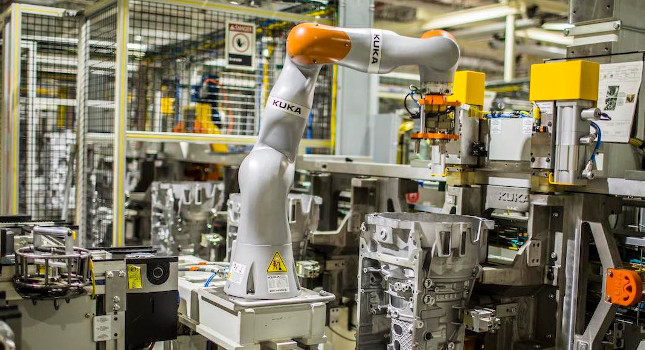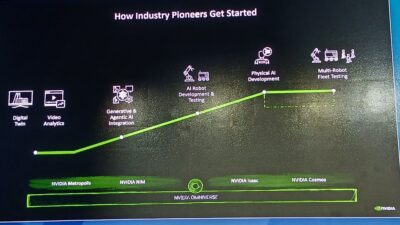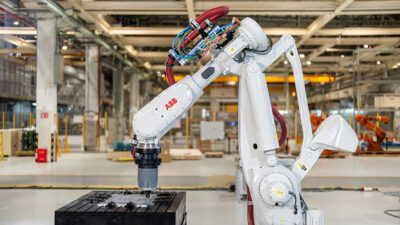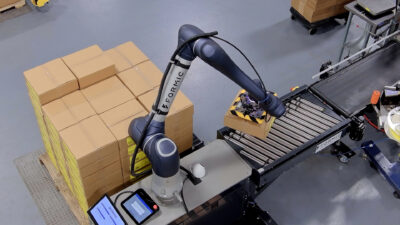Some of the main trends for robotics in 2022 include a greater emphasis on flexibility as well as developments in artificial intelligence (AI).

One thing we can expect to see from robots in 2022 is greater flexibility. In a recent interview, Wendy Tan White, CEO of the robotics software company Intrinsic, predicted more creativity and innovation emerging from the industrial robotics space. She believes that we are on the cusp of an industrial robotics renaissance, driven by software-first solutions, cheaper sensing, and more abundant data.
Manufacturers today are seeking to do more with robots. Purchasers expect smaller and more flexible designs that can fit easily into existing production lines, or for their existing robots to be easily repurposed and reassigned to tasks.
There will be growing demand for robots to function outside of normal manufacturing spaces – in other areas like logistics, warehouses or laboratories. Collaborative robots (cobots), in particular, will continue to present possibilities for greater cooperation and collaboration with humans. A famous example is Amazon’s Kiva robots, which are roboticized pallet jacks that follow workers around the warehouse and support them in their tasks.
In 2022 and beyond, robots will increasingly be used to pick and move products in warehouses or around the production line. Other growth areas will include cobots that operate and tend to computer numerical control (CNC) machines. There are also increasing possibilities in welding applications. But, are robots properly equipped to perform these varied roles?
Vision systems
One feature that will be integral to robots performing new tasks, such as picking and moving products in warehouses, will be the increased use of 2D and 3D vision systems. Whereas ‘blind’ robots – or those without vision systems – can complete simple repetitive tasks, robots with machine vision can react intuitively to their surroundings.
With a 2D system, the robot is equipped with a single camera. This approach is better suited for applications where reading colors or textures is important, like barcode detection. 3D systems, on the other hand, evolved from spatial computing first developed at Massachusetts Institute of Technology (MIT) in 2003. They rely on multiple cameras to create a 3D model of the target object and are suited to any task where shape or position are important – such as bin picking.
Both 2D and 3D vision systems have a lot to offer. 3D systems, in particular, can overcome some of the errors 2D-equipped robots encounter when executing physical tasks that would otherwise leave human workers to diagnose and solve the malfunction or resulting bottleneck. Going forward, robots equipped with 3D vision systems have potential for reading barcodes and scanners, checking for defects such as in engine parts or wood quality, packaging inspections, checking the orientation of components and more.
The right pick
In the coming years the focus of robotics will shift beyond sensor device hardware towards building AI that can help optimize the use of sensors, and ultimately improve performance.
A combination of AI, machine vision, and machine learning are set to usher in the next phase of robotics. Expect to see more data management and augmented analytics systems that are all geared towards helping manufacturers achieve higher levels of operational excellence, resilience and cost-efficiency.
This will include combinations of machine vision with learning capabilities. Take precision bin picking applications, for example – one of the most sought-after tasks for robots. With previous robot systems, professional computer aided design (CAD) programming was needed to ensure the robot could recognize shapes. While these CAD systems could identify any given item in a bin, the system would run into issues if – for example – items appeared in random order during a bin picking task.
Instead, advanced vision systems use passive imaging, where photons are emitted or reflected by an object which then forms the image. The robot can then automatically detect items, whatever their shape or order.
An example of this is Shibaura Machine’s vision system, TSVision3D, which uses two high-speed cameras to continuously capture 3D images. Using intelligent software, the system can process these images and identify the exact position of an item. Through this process, the robot can determine the most logical order and pick up items with sub-millimeter accuracy, with the same ease as a human worker.
There is great potential for robotics in combining machine vision with robot learning. Possible applications include vision-based drones, warehouse pick and place applications and robotic sorting or recycling.
Trial-and-error process
With TSVision3D, we are seeing robot AI evolve to the point where it can interpret images as reliably as humans. Another key feature of this evolution is machine learning that allows robots to learn from mistakes and adapt.
One example is the DACTYL robotic system created by OpenAI, an artificial intelligence research laboratory founded by magnates Elon Musk and Sam Altman. With the DACTYL system, a virtual robotic hand learns through trial and error. This data is transferred to a real-life dextrous robotic hand and, through human-like learning, the robot is able to more-efficiently grasp and manipulate objects.
Otherwise known as deep learning, this process is the next step for robot AI. It is hoped that through trial-and-error activities, as with the DACTYL system, robots will learn to perform more varied tasks in different environments.
Edge intelligence
Put simply, edge computing means moving data processing as close as possible to its source of origin in order to better obtain and prioritize data. Rather than ‘dumb’ sensors, like standard microphones or cameras, it involves the use of smart sensors – like microphones equipped with language processing capabilities, humidity and pressure sensors, or cameras outfitted with computer vision.
Edge computing can combine with the technologies mentioned above. So, a robotic arm can take a reading through a smart sensor and 3D vision system, then send it to a server with a human-machine interface (HMI) where a human worker can retrieve the data. With edge systems less data is sent to and from the cloud, which relieves network congestion and latency and allows computations to be performed more quickly. These Industry 4.0 innovations will complement the latest end-of-arm tooling hardware systems – like grippers for robots or clamping systems for machining centers – which are getting more precise year-on-year.
We should expect to see more creativity and innovation emerging from within the industrial robotics space. Improved vision systems, AI and edge systems can also combine to help ensure both manufacturers and their robots continue to thrive in the coming years.
– This originally appeared on Control Engineering Europe’s website. Edited by Chris Vavra, web content manager, Control Engineering, CFE Media and Technology, [email protected].



